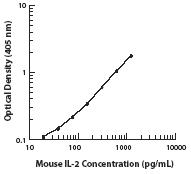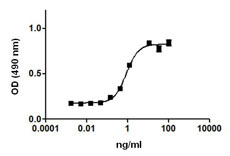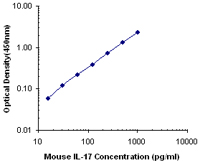- Clone
- JES6-5H4 (See other available formats)
- Regulatory Status
- RUO
- Other Names
- Interleukin-2, T cell growth factor (TCGF), Eosinophil differentiation factor (EDF), Killer cell helper factor (KHF), Macrophage-activating factor for cytotoxicity I (MAF-C I), Thymocyte differentiation factor (TDF)
- Isotype
- Rat IgG2b, κ
- Ave. Rating
- Submit a Review
- Product Citations
- publications

| Cat # | Size | Price | Quantity Check Availability | Save | ||
|---|---|---|---|---|---|---|
| 503803 | 50 µg | 81€ | ||||
| 503804 | 500 µg | 220€ | ||||
IL-2 is a potent lymphoid cell growth factor which exerts its biological activity primarily on T cells. Additionally, IL-2 has been found to stimulate growth and differentiation of B cells, NK cells, LAK cells, monocytes, and oligodendrocytes.
Product DetailsProduct Details
- Reactivity
- Mouse
- Antibody Type
- Monoclonal
- Host Species
- Rat
- Immunogen
- E. coli-expressed, recombinant mouse IL-2
- Formulation
- Phosphate-buffered solution, pH 7.2, containing 0.09% sodium azide.
- Preparation
- The antibody was purified by affinity chromatography, and conjugated with biotin under optimal conditions.
- Concentration
- 0.5 mg/ml
- Storage & Handling
- The antibody solution should be stored undiluted between 2°C and 8°C. Do not freeze.
- Application
-
ELISA Detection, ELISPOT Detection, ICFC
- Recommended Usage
-
Each lot of this antibody is quality control tested by ELISA assay. For use as an ELISA detection antibody, a concentration range of 0.25-1.0 µg/ml is recommended. To obtain a linear standard curve, serial dilutions of IL-2 recombinant protein ranging from 250 to 2 pg/ml are recommended for each ELISA plate. For use as an ELISPOT detection antibody, a concentration range of 1-4 µg/ml is recommended. It is recommended that the reagent be titrated for optimal performance for each application.
- Application Notes
-
ELISA Detection1-3 or ELISPOT Detection4-6: The biotinylated JES6-5H4 antibody is useful as a detection antibody for a sandwich ELISA or ELISPOT assay, when used in conjunction with the purified JES6-1A12 antibody (Cat. Nos. 503701 & 503702) as capture antibody and recombinant mouse IL-2 (Cat. No. 575409) as the standard.
Flow Cytometry8-10: The fluorochrome-labeled JES6-5H4 antibody is useful for intracellular immunofluorescent staining and flow cytometric analysis to identify IL-2 -producing cells within mixed cell populations.
Neutralization1,7: The Ultra-LEAF™ purified antibody (Endotoxin in vivo and in vitro (Cat. No. 503845-503850)) is recommended for neutralization.
Additional reported applications (for the relevant formats) include: immunoprecipitation1, immunohistochemical staining of paraformaldehyde-fixed, saponin-treated frozen tissue sections2, in vivo capture7, and immunocytochemistry.
Note: For testing mouse IL-2 in serum, plasma or supernatant, BioLegend's ELISA MAX™ Sets (Cat. No. 431001 & 431004) are specially developed and recommended. - Application References
-
- Abrams J, et al. 1992. Immunol. Rev. 127:5.
- Sander B, et al. 1993. J. Immunol. Meth. 166:201.
- Abrams J. 1995. Curr. Prot. Immunol. John Wiley and Sons New York. Unit 6.20.
- Klinman D, et al. 1994. Curr. Prot. Immunol. John Wiley and Sons New York. Unit 6.19.
- Mo X, et al. 1995. J. Virol. 69:1288.
- Karulin A, et al. 2000. J. Immunol. 164:1862.
- Finkelman F, et al. 2003. Curr. Prot. Immunol. John Wiley & Sons New York. Unit 6.28.
- Ko SY, et al. 2005. J. Immunol. 175:3309. PubMed
- Kang SS and Allen PM. 2005. J. Immunol. 174:5382.
- Lawson BR, et al. 2007. J. Immunol. 178:5366.
- Product Citations
- RRID
-
AB_315297 (BioLegend Cat. No. 503803)
AB_315298 (BioLegend Cat. No. 503804)
Antigen Details
- Structure
- Cytokine; 15-30 kD (Mammalian)
- Bioactivity
- Proliferation of T lymphocytes, B cells, anti-inflammatory, hematopoiesis, tumor surveillance
- Cell Sources
- T cells
- Cell Targets
- T cells, B cells, NK cells, LAK cells, monocytes, macrophages, oligodendrocytes
- Receptors
- High affinity heterotrimer of IL-2Rα/β/γ, intermediate affinity homodimer IL-2Rα (CD25; p55; Tac) and heterodimer IL-2Rβ (CD122)/γ; γ-subunit (CD132) in common with IL-4R, IL-7R, IL-13R, IL-15R
- Cell Type
- Tregs
- Biology Area
- Immunology
- Molecular Family
- Cytokines/Chemokines
- Antigen References
-
1. Fitzgerald K, et al. Eds. 2001. The Cytokine FactsBook. Academic Press San Diego.
2. Taniguchi T, et al. 1993. Cell 73:5.
3. Nistico G. 1993. Prog. Neurobiol. 40:463.
4. Waldmann T, et al. 1993. Ann. NY Acad. Sci. 685:603. - Regulation
- Upregulated by NFAT; downregulated by TCF-8, CIF (colostrum inhibitory factor)
- Gene ID
- 16183 View all products for this Gene ID
- UniProt
- View information about IL-2 on UniProt.org
Related FAQs
- How many biotin molecules are per antibody structure?
- We don't routinely measure the number of biotins with our antibody products but the number of biotin molecules range from 3-6 molecules per antibody.
Customers Also Purchased
Compare Data Across All Formats
This data display is provided for general comparisons between formats.
Your actual data may vary due to variations in samples, target cells, instruments and their settings, staining conditions, and other factors.
If you need assistance with selecting the best format contact our expert technical support team.
 Login / Register
Login / Register 
















Follow Us